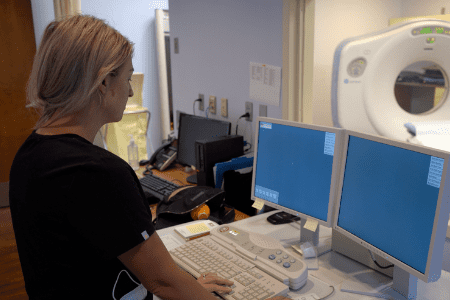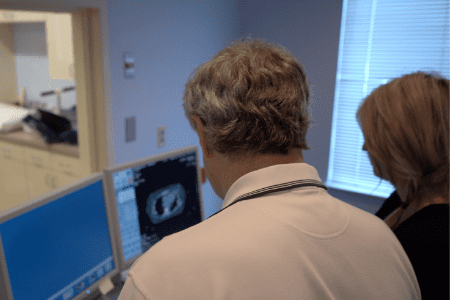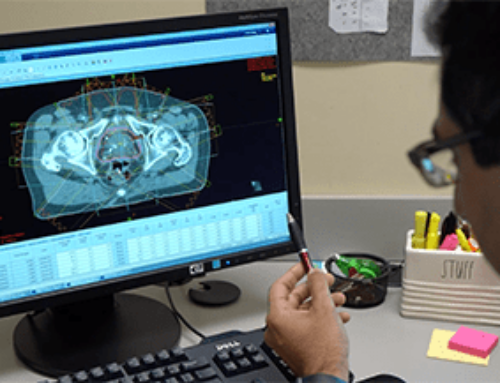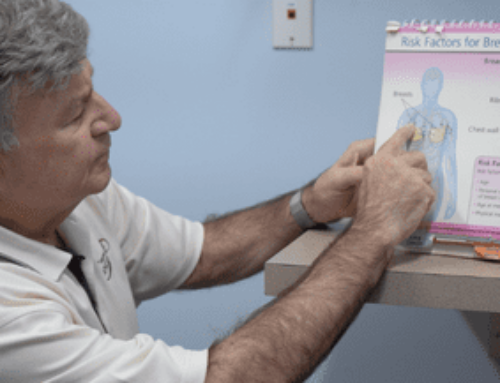 What is external beam radiation therapy?
What is external beam radiation therapy?- Why would my doctor prescribe external beam radiation therapy for my prostate cancer?
- Are there different types of external beam radiation therapy treatments?
- Are there risks associated with external beam radiation therapy for prostate cancer?
- What’s it like to have external beam radiation therapy for prostate cancer?
Nearly 250,000 men will be diagnosed with prostate cancer this year. Prostate cancer is second only to skin cancer as the most common type of malignant cancer that men experience. While prostate cancer is a terrible diagnosis for you to hear, there is hope in the fact that the 10-year survival rate for this disease is 98%.
The death rate from prostate cancer has been dropping steadily thanks to earlier diagnosis of the disease and the new technologies that improve treatment for it. This article discusses one of the most innovative treatment approaches available today to men with prostate cancer: external beam radiation therapy.
What Is External Beam Radiation Therapy?
External beam radiation therapy is a localized treatment that emits high-energy X-ray beams to target cancer cells. This treatment is standard for all kinds of cancers, including the prostate. The radiation is emitted from a large machine called a linear accelerator that can rotate around the body and hone in on one specific area. This reduces the chances that the radiation affects the healthy tissue surrounding the cancer.
External beam radiation therapy targeted at prostate cancer kills off the malignancy at the cellular level where the cancer divides and spreads. The treatment goal is to use the targeted radiation to kill off as much of the malignancy as possible without affecting too much of the tissue that isn’t cancerous.
Why Would My Doctor Prescribe External Beam Radiation Therapy for My Prostate Cancer?
External beam radiation therapy is a standard treatment for prostate cancer. It’s a primary treatment for cancer that is caught early before it has spread to other parts of the body. External beam radiation therapy can be used with other types of cancer treatments, such as hormone therapy, when the disease is serious.
Your doctor could also order external beam radiation after you’ve had surgery. This is called adjuvant therapy, and its goal is to lower the risk that your cancer will return. Your doctor will monitor the levels of prostate-specific antigen (PSA) with blood work and will also watch for signs of cancer in your pelvic area.
If your prostate cancer is advanced, external beam radiation therapy may also help with bone pain or other symptoms.
Are There Different Types of External Beam Radiation Therapy Treatments?
 There are several different types of external beam radiation therapies, including:
There are several different types of external beam radiation therapies, including:
- Image-guided radiation therapy, which uses computer imaging to map the prostate location and then aim radiation beams to the precise spot
- Intensity-modulated radiation therapy (IMRT), which uses a computerized machine to sculpt the radiation beam to match the shape of the cancer
- Proton beam radiation therapy, which uses proton beams instead of X-rays
- Stereotactic body radiation therapy (SBRT), which delivers large radiation doses in a concentrated way over several days
The type of external beam radiation therapy your doctor selects will depend on several factors including the level of cancer you’re experiencing, your overall health, and your goals for the treatment.
Are There Risks Associated With External Beam Radiation Therapy for Prostate Cancer?
There are risks associated with the use of radiation therapies. The severity of your side effects will depend upon the intensity of the treatments you undergo. Most of these side effects are both temporary and able to be controlled by your doctor.
With radiation treatments, we have acute side effects (seen during and immediately after a course of treatments) and late side effects. If your treatment is prostate only then you will have some irritative symptoms of the urinary tract and rectum. If your Doctor recommends the pelvic lymph nodes be treated then you see more irritated GI side effects such as bowel urgency and diarrhea.
Almost all of these side effects are reduced by managing them with medications and/or diet changes. Patients do experience some fatigue and this is more pronounced on hormonal therapy during the radiation.
Late side effects can manifest at any time. The more severe side effects such as severe bleeding are fairly rare. Erectile dysfunction is common but with the use of medications, this can often be corrected.
We are often asked about incontinence of urine and that is a very rare side effect from radiation as relates to complete leakage. Some patients may get in situations where they cannot logistically get to a bathroom on a timely basis and one of those rare occasions will have what is called urge incontinence.
There are other very rare side effects but the above covers the usual events we see.
Some of these side effects may occur just after the treatment. Others may show up years later. Talk with your doctor about the specific type of external beam radiation therapy you undergo and ask about the side effects you may experience.
What’s It Like to Have External Beam Radiation Therapy for Prostate Cancer?
 Before you undergo external beam radiation therapy, your clinical team will map out where the cancer is located so that they can better target the radiation therapy. The goal is to treat just that area, and nothing more. This will reduce your chances of experiencing side effects. This process typically includes:
Before you undergo external beam radiation therapy, your clinical team will map out where the cancer is located so that they can better target the radiation therapy. The goal is to treat just that area, and nothing more. This will reduce your chances of experiencing side effects. This process typically includes:
- A radiation simulation where the clinical team helps you find the most comfortable spot to rest in during your treatment
- Computerized tomography (CT) scanning so that your doctors can precisely map the area of your body that needs treatment
During the external beam radiation treatment, you will rest on a table and hold very still while the linear accelerator moves around you to deliver the treatment. You may have an immobilization device to hold you in position to ensure the radiation goes exactly where it should. Your job during the treatment is to relax, breathe normally, and hold still. External beam radiation therapy for your prostate is not a painful treatment. You should be able to rest comfortably while the treatment is given.
The machine will deliver a very precise dose of radiation prescribed by your doctor. Each treatment usually lasts less than an hour and most of that time is spent preparing for the dosage. The radiation treatment itself is usually just a few minutes. During this time, your clinical team will be outside the room but able to see and talk with you through cameras and an audio connection.
External beam radiation therapy for your prostate cancer is typically given on an outpatient basis and administered regularly every day for a week or longer.
We know a diagnosis of prostate cancer can be frightening, but our team at the Central Florida Cancer Care Center is standing by. Our innovative treatments are ready to help you beat prostate cancer so you can live life to its fullest.





